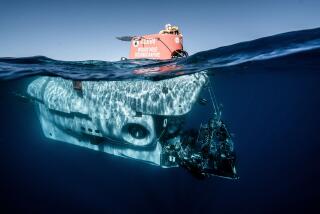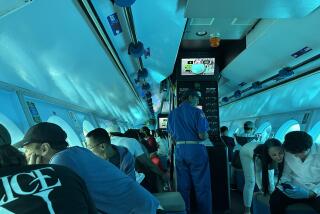IRVINE : For Mini-Sub, Time to Sink or Swim
After working all year on their senior class project, five engineering students at UC Irvine will find out today if their design flies. Or in this case, sinks.
The mechanical engineering students plan to test their bright yellow, 5,000-pound, steel mini-submarine in a 1-million-gallon pool at McDonnell Douglas Space Systems in Huntington Beach that normally is used to test space-station equipment.
“This is the only time we’ll be able to test it in a controlled environment,” said Scott Emigh, 22, one of the project members. “The next time we put it anywhere it will be in the ocean.”
Although a major leak or crack in the hull probably won’t earn the students an F, today’s test will show whether the hull and especially a 280-degree clear acrylic viewing port at the front of the craft can survive pressure equivalent to a 60-foot dive.
On hand for the test will be team members Mike Kadell, 32, Ross Blair, 22, Gil Hurtado, 24, and Dwayne Dodd, 22.
“The acrylic, if that were to break or crack on the sides--and I’m giving Mike (Kadell) a headache now just saying that--that will be a major disaster,” Emigh said Thursday as the team used a pump to pressurize the mini-sub’s air tanks.
Kadell designed the acrylic bubble to withstand pressure from a 150-foot dive.
Although the craft looks a little rough around the edges and a bit primitive inside with hoses and wires dangling here and there, a computer simulation says it can withstand 66 pounds of pressure per square inch, Emigh said.
Still, for safety’s sake, the craft will make its maiden voyage unmanned. If the trip is a success, a manned voyage will take place Saturday.
“The problem with computer models is they don’t take into account the proficiency of the welders,” Emigh joked. The students spent the last six weeks welding the 11-foot-long frame and hull together from steel pieces that didn’t always fit together just right, he said.
“You should have seen it before we painted it,” he said. “The paint hides a lot.”
The students have been building the submarine, which they dubbed the “Kobyoshi Maru” as an inside joke to fellow “Star Trek” fans, for the past eight weeks on a UCI loading dock. The name means “impossible mission” in the Vulcan language, Emigh said, which typifies the reaction they got from engineering professors last fall when they first thought of building the mini-sub.
Each mechanical engineering student at UCI spends the year in a team designing, building and testing some device that meets with faculty approval. Students are given $60 each to help defray the cost.
So far, members of the Kobyoshi Maru team have spent about $1,500 each from their own pockets, as well as receiving thousands of dollars worth of donated equipment and supplies, Emigh said.
The mini-sub includes its own self-contained life-support system, designed by Blair, which filters carbon dioxide and moisture from the air and feeds in puffs of air. Other features include seven motors controlled by two joy sticks for maneuverability, ballast tanks blown by high-pressure air and a battery system for power.
But the best feature, Emigh said, is the clear bubble front that allows the two explorers to see up and down as well as forward.
“Our pride and joy is that it has better visibility than any other (submarine) design we saw,” he said. The students reviewed the designs of about 150 other mini-submarines before beginning.
The submarine is meant to be able to lurk in the ocean depths for at least two hours at pressures even an experienced diver could withstand for only a few minutes, Emigh said.
If a submarine being built on the engineering building’s loading dock sounds a little strange, other senior projects this year include a small, remotely controlled cargo plane, a blimp, an ultralight aircraft and a solar-powered car.
“For some reason,” Hurtado said, “this year all the projects are pretty large and ambitious.”
More to Read
Sign up for Essential California
The most important California stories and recommendations in your inbox every morning.
You may occasionally receive promotional content from the Los Angeles Times.










